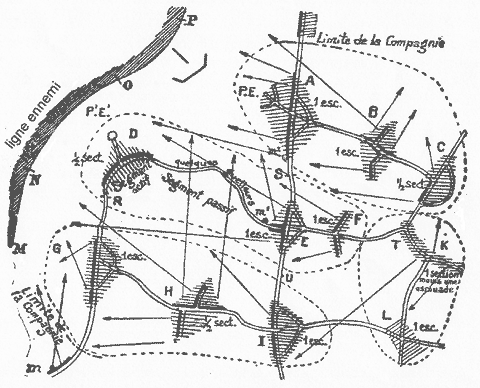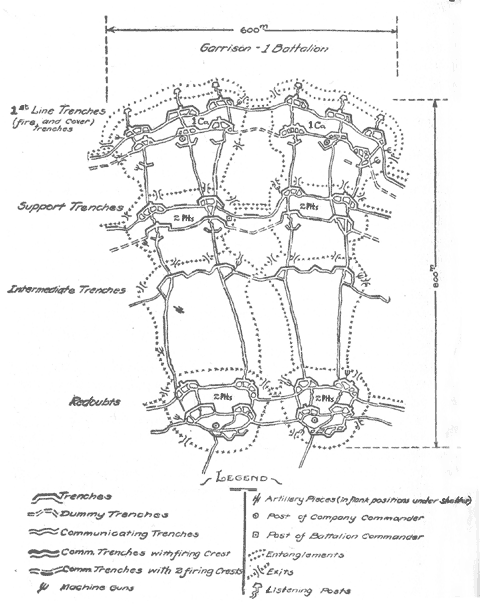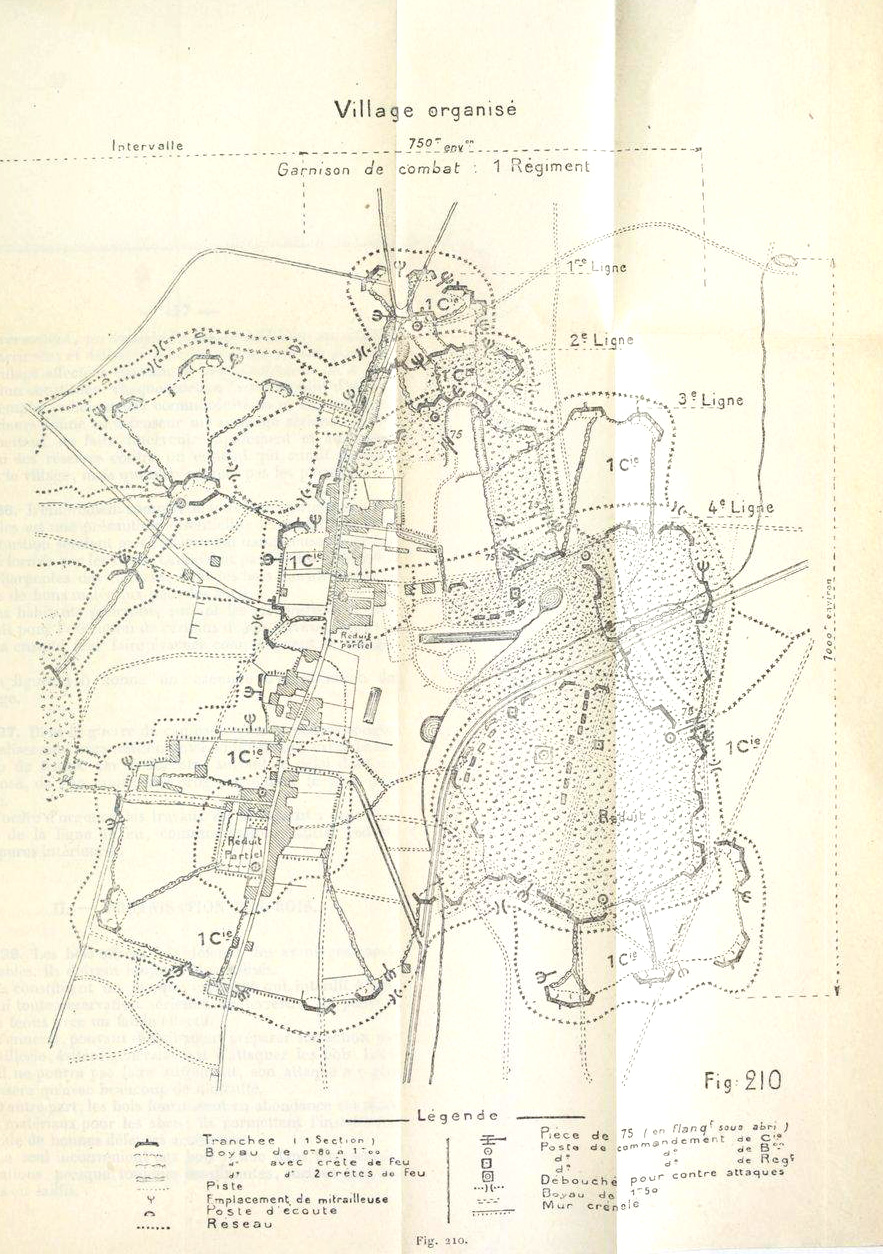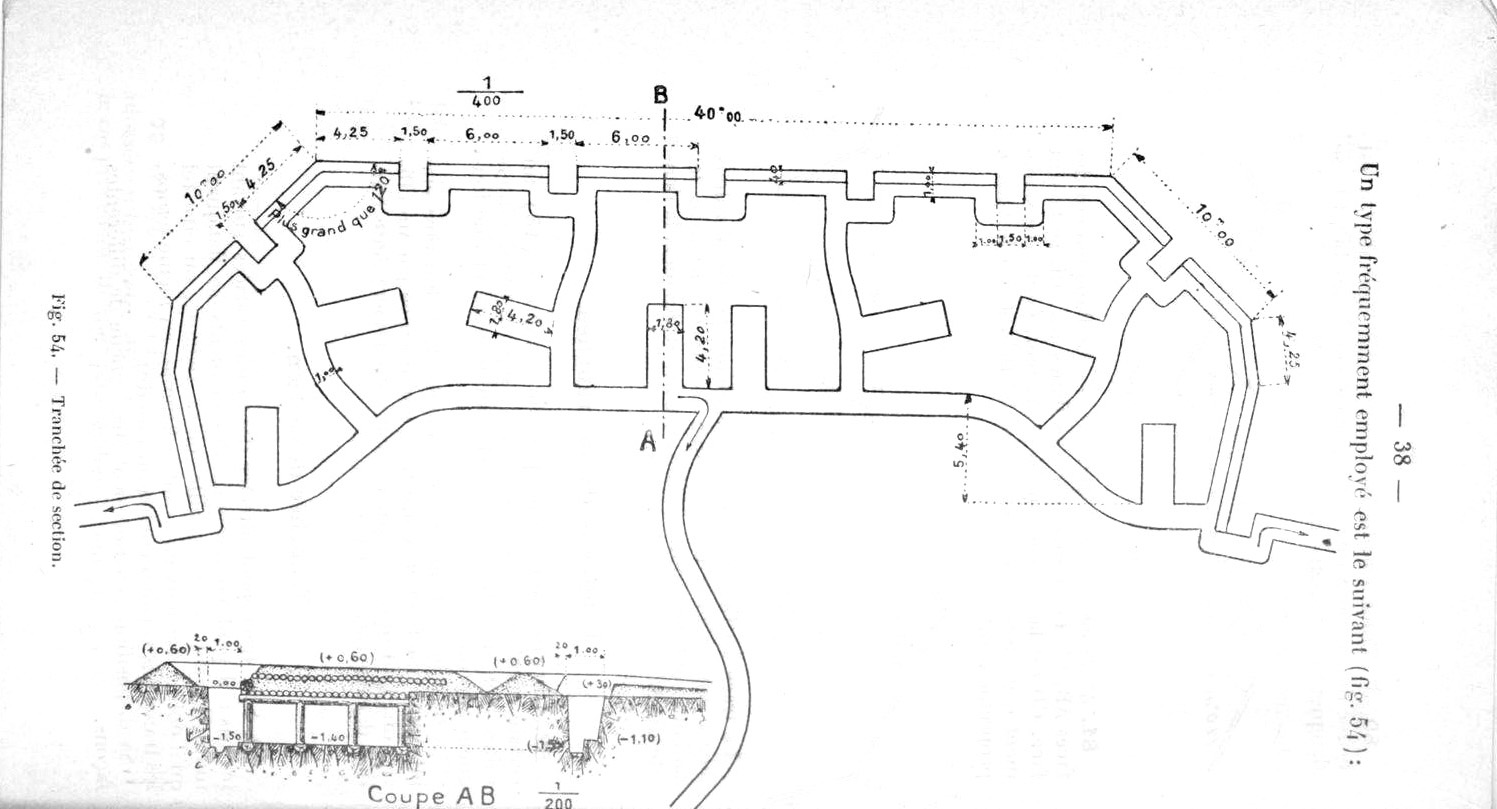General Layout of a French Trench System 1916-1918
While a large offensive was being waged, the numbers of men and the amounts of matériel were so great, that a continuous line of resistance was unavoidable. However, in times of calm or on stable fronts, such precautions were unnecessary. In these cases, it sufficed to simply hold the ground with as few effectives as possible, thus freeing up forces to be alotted elsewhere as neeeded.
Beginning in early 1915, the French army began laying down a pattern of 'active' and 'passive' zones. Ideally under this system, the active zones or "elements" were made up of ouvrages or points d'appui ("works" or "strong-points") offering flanking and frontal fire together with sheltered positions for small garrisons of troops. They were distinct islets of defense generally made up of a small knot of trenches and barricades. The strength of the garrison varied from a escouade ("squad," also referred to as a group; 7-13 men) to a section (the equivalent of a platoon; roughly 100 men).
The passive zones were heavily wired and manned only by a small number of sentries. They were covered by the strong-points or by a "cover" trench immediately in the rear and acted as communication routes between active zones. Passive zones could also be utilized as counter-attack routes in event of an enemy intrusion in the lines. In order to deceive the enemy's intelligence, it was necessary that the active and passive zones resemble each other to a degree so as to not give away the layout of the positions or troop placements. Dummy trenches, barricades and small works were therefore built (though not manned, per se) in the passive zones for this purpose.
One soldier wrote the following: "[The old front line] held by an unbroken line of soldiers standing in the trenches shoulder to shoulder...had been replaced by a series of strong-points divided from one another by as much as four or five hundred yards." In the Spring of '18, the war of movement resumed and combat was once again waged on open ground. With soldiers constantly on the move, this meant life in shell-holes, fox-holes and shallow trenches. As such, soldiers usually fought, ate and slept with little or no shelter.
Possible Layout of a Company in a Strong-Point System
The Platoon Leader's Guide (ed. 1917) (see description below)

The above diagram illustrates one possible layout of a system of strong-points and troop alottments therein. These matters are contingent upon the circumstances as they exist in the field---terrain, distance between the two opposing lines, activity level of the sector, etc---and therefore actual layouts could vary from the model shown. The arrows indicate lines of fire and the dotted lines represent the area occupied by one section (100 men). The cross-hatching marks active zones while the space inbetween these are passive. In the center, position 'R-D' is occupied by a half-section (i.e. two squads, 14-28 men), 'E' by one squad and 'F' by one squad. Between positions 'R-D' and 'E' is a passive zone occupied by only a few sentries. All positions are offered covering fire on the flanks and/or from the rear.
The reliance on strong-points for defense became even more pronounced by late-war. The last great 'breakthrough' attack by the French army during the Aisne offensive of April 1917, ended only in disaster. Pétain was put in command to establish order in an army on the verge of total breakdown. He soon established a system of "defense in depth" which revolved around the formation of "centers of resistance." This system originally appeared the previous year during the defense of Verdun when line officers and NCOs began to first realize the benefit of "defense in depth".
It entailed that the main opposition to enemy attack was in the second line with the first acting only to slow it down. The first line or 'fire trench', was to be manned with only the minimum number of men needed to hold it. Generally, this meant grenadiers, automatic riflemen, machine-gunners, and a handful of riflemen. In case the enemy overwhelmed the first line defenses, the second or support line (200-500 meters behind) would provide both frontal and flanking fire, along with counter-attack troops. The third line would provide reinforcements for a counter-attack in case of a breakthrough by the enemy. By late-war this line consisted of redoubts, theoretically in the shape of a polygon, and utilizing chains of blochaus ("blockhouses")--concrete machine-gun emplacements. These were also known as grandes guardes ("big defenses" or "stong-holds"). Interlocking fire zones between each of the respective lines were key to its success. A "center of resistance" was this entire formation--first, second and support lines--as broken down on a sector by sector basis. At any given time, one-quarter to one-third of unit's strength was assigned to the first line and cover trenches, with the rest being distributed between the second and third lines.


Example of a lunette incorporated into a trench system






